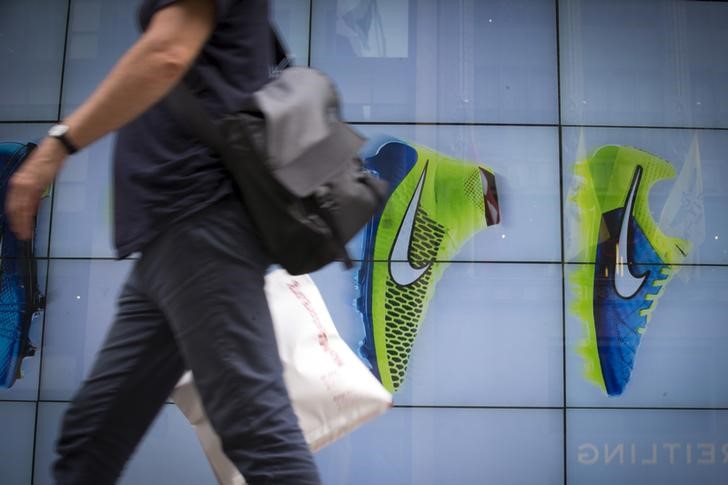Investing.com — The main indices point toward a weaker open on Wall Street, amid a degree of caution ahead of the release of key U.S. inflation numbers. A weak outlook from sporting retail giant Nike also weighed, although a continuation of the year-end rally with weekly gains still looked likely. The news in the U.K. was less impressive, as its economy retreated in the third quarter, opening up the possibility of a recession to end the year.
1. Fed’s favorite inflation gauge looms
Investors will get one more look at the inflation picture in the U.S. before they head off for their Christmas holidays with the release of the personal consumption expenditures report, the Fed’s primary inflation gauge, for November.
Economists are expecting the to remain flat for a second month in November, while the measure that strips out volatile food and energy costs is seen rising 0.2%.
A more dovish tone from the Federal Reserve at its last meeting has resulted in investors pricing in around 150 basis points of interest rate cuts next year, particularly as evidence mounted that price pressures are easing and the labor market is cooling in the face of the aggressive rate hikes from March 2022 to July 2023.
Any signs of sticky inflation are likely to dent these rate cut expectations, but Thursday’s downward revision to the PCE in third-quarter growth data bodes well for a downside surprise.
2. Futures slip but Wall Street on course for another positive week
U.S. stock futures fell on Friday amid caution ahead of key inflation data, although the year-end rally looks set to continue with more weekly gains.
By 04:55 ET (09:55 GMT), the contract was down 100 points, or 0.3%,, had dipped by 4 points or 0.1%, and had fallen by 40 points or 0.2%.
The three main indices closed strongly on Thursday, bouncing back after the losses of the previous session. The blue-chip gained over 300 points, or 0.9%, while the broad-based rose 1% and the tech-heavy climbed 1.3%.
These averages are on course for their eighth positive week in a row – a first for the S&P 500 since 2017 and for the DJIA dating back to 2019.
That said, the session could well start on a negative note given the weakness of Dow-component Nike (NYSE:) (see below) and amid caution ahead of the release of the Fed’s most-watched inflation gauge (see above).
That said, financial markets will “take off” once investors are sure the Federal Reserve has finished raising interest rates, said Morgan Stanley’s outgoing CEO James Gorman, in an interview with the Financial Times, reported on Friday.
“The minute the Federal Reserve has concretely signalled that they’ve stopped raising rates, let alone the point at which they first do a rate cut, these markets will take off,” he said.
3. Nike slumps after consumer demand warning
Shares in Nike slumped in premarket trading in New York on Friday after the sportswear giant cut its annual sales forecast, warning of a softer second-half revenue outlook on cautious consumer spending.
Nike now sees full fiscal-year revenue to rise about 1%, down from its prior forecast of mid-single-digit percentage growth. Analysts had expected a 3.8% increase, according to LSEG data.
“We are seeing indications of more cautious consumer behavior around the world,” Nike’s chief financial officer Matthew Friend said on a post-earnings call.
The Oregon-based company has been under persistent pressure amid choppy demand, particularly from China as growth in the second-largest economy in the world slowed, forcing the company to boost promotions.
Nike has responded to the uncertain situation, targeting up to $2B in cost savings over three years that will be driven by simplifying product assortment, increasing automation and use of technology, and streamlining operations.
4. U.K. heads towards recession
The U.K. economy is looking clearly at recession after a revision to previously released growth data, released earlier Friday, showed that it shrank between July and September, ahead of the potentially weak final quarter of the year.
contracted by 0.1% in the third quarter, according to data from the Office for National Statistics, a downward revision after the independent producer of official statistics had previously estimated that the economy was unchanged from the previous three months.
Similarly, second-quarter GDP was now estimated to have been flat, a cut from a previous estimate of 0.2% growth.
A recession is officially defined by two consecutive quarters of negative growth, and this puts the focus on the final quarter of the year amid signs the U.K. economy is still struggling with the hit from higher borrowing costs yet to fully filter through.
5. Oil gains despite Angola’s decision to leave OPEC
Oil prices rose Friday, on course for hefty weekly gains, following concerns over shipping in the Red Sea after a series of Houthi attacks on vessels in the region.
By 04:55 ET, the futures traded 1.2% higher at $74.78 a barrel, while the contract climbed 1% to $80.16 per barrel.
Both the benchmark contracts are over 4% higher this week, set for a second consecutive week of strong gains, on expectations of supply shortages, particularly in the key Asian market, as several oil and shipping firms opted to avoid using the Suez canal, which handles about 12% of worldwide trade.
Capping the gains has been Angola’s decision to leave the Organization of Petroleum Exporting Countries, saying its membership was not serving its interests.
OPEC and its allies, including Russia, have been cutting production levels in a series of steps in order to boost prices, including voluntary output cuts totalling about 2.2 million barrels per day for the first quarter of 2024.
The African country had previously protested a decision to reduce the country’s oil output quota for 2024.
Although Angola accounts for only a small portion of overall output by the cartel, and Brazil is set to join the group next year, the move raises concerns over the cartel’s unity as a whole.
Read the full article here







